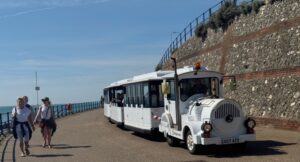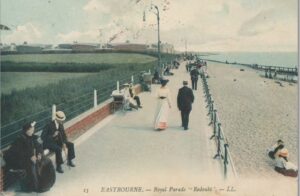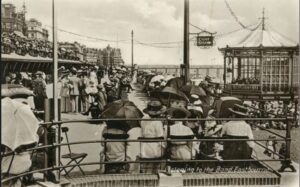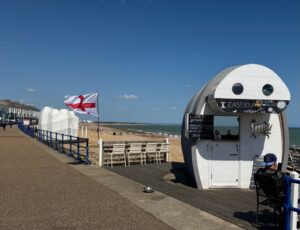 It’s been an odd few days. Wednesday’s hike around East Dean and the Seven Sisters was splendid but it knocked the stuffing out of me. I was still sensing the retreating ripples of stiffness this morning, four days later, but a sunny Sunday morning was too irresistible, so I pulled on one of my Almeria shirts and headed out. Glad I did.
It’s been an odd few days. Wednesday’s hike around East Dean and the Seven Sisters was splendid but it knocked the stuffing out of me. I was still sensing the retreating ripples of stiffness this morning, four days later, but a sunny Sunday morning was too irresistible, so I pulled on one of my Almeria shirts and headed out. Glad I did.
A warm weekend means a busy seafront, and would normally be a time to avoid. But my physio had instructed me to “have a proper run” over the weekend, and this was my chance. As it turned out, leaving home a few minutes before 10am was just early enough to enjoy plenty of company while missing the worst of the weekend congestion. On this warm and beautifully sun-struck Sunday morning, the atmosphere was somehow joyous and unshackled. The usual melange of townsfolk and visitors had turned out to grab a few rays and marvel at the sea nudging the distant horizon. A leisurely promenade along the front is a long-established pastime, as Victorian and Edwardian era photos confirm.


We wear fewer clothes on the seafront these days. We smoke different substances. And we jog. I lost count of the number of runners out there today. Most were members of the Beautiful People Club, dressed in black lycra and wearing running vests. A running vest used to mean a singlet. An armless top. Now it’s something else. It’s one of those black high-tech sort-of waistcoats that people buckle themselves into, as if they’re about to head off into combat or be launched into space. It’s the most obvious visible change between the running worlds of 2013 and 2025: the introduction of the running vest with all those handy pockets for phone and keys and gels and water bottles. I don’t mean to make light of them. It seems like a useful innovation, and almost certainly handier than the belt I still use, and that tends to bounce around my midriff if I download too many podcasts. 
Part of my own joy came from the success of the outing. Driving down to the seafront, I was twitchy about the jaunt ahead. Had it not been for my physio ordering me to drag myself out of my comfort zone, I’d no doubt have tiptoed through another session of alternating two-minute runs and walks. Instead I embarked on what seemed like a foolish and risky plan: 3R, 2W, 5R, 2W, 7R, 2W, 3R, 2W, 12R, for a total of 30 minutes of running. 30 minutes? This was much more than my pre-injury figures, and I had no idea what night happen.
What did happen was that I started off well, continued well, and finished well. Even the final 12 minute stretch, which I’d pencilled in as an outlandish option should I emerge from the earlier legs unmarked, wasn’t too uncomfortable. I could have pushed it to 20 minutes I’m sure, but that would have seemed like a very foolish move. It meant that my final 10-minute warm-down walk was as relaxed, as calm, and as smug as anything I’ve felt after a run for a very long time, and has given me plenty of confidence about being able to push on — eventually.
30 minutes of running without a break is always the target for the new or returning runner. It’s the far-distant mountain that new C25K plodders peer at in awe, and is the figure that the Hal Higdon manuals specify as a minimum starting point for the novice marathon runner. That has to be my target now too. So I’ll not aim to extend the jogging just yet, but to shorten or remove some of the walks, leaving the 30 minutes’ running in an ever-shallower pool of recovery breaks. While the euphoria is still wet, that’s the plan I see swimming around before my eyes. Of course, my entire unremarkable running career has been characterised by wild and overconfident conjecture about where my progress is inevitably leading — predictions that usually crumble to dust as soon as they are formed — so I’d better say no more on the topic.
 I was struck today by the difference between running slowly and walking quickly. At my level, there isn’t that great a disparity in pace, so they shouldn’t make me feel much different. But they do. There really is a distinction. Even the mildest of plods detonates a dissimilar explosion of endorphins compared with the low-key lot that pop up after a strenuous walk. It’s whole different vibe, mentally and physically, and it continues to makes itself known long after the initial execution, and well into the all-important aftermath — where the richest of benefits reside. A long walk is satisfying, but I’ll feel tired and achey. I could lie down and take a nap, as I did after Wednesday’s hike. But a decent run means feeling energised, more awake and more alive than seems reasonable. It’s miraculous and magical, and it’s a big part of why, well, running really is the answer.
I was struck today by the difference between running slowly and walking quickly. At my level, there isn’t that great a disparity in pace, so they shouldn’t make me feel much different. But they do. There really is a distinction. Even the mildest of plods detonates a dissimilar explosion of endorphins compared with the low-key lot that pop up after a strenuous walk. It’s whole different vibe, mentally and physically, and it continues to makes itself known long after the initial execution, and well into the all-important aftermath — where the richest of benefits reside. A long walk is satisfying, but I’ll feel tired and achey. I could lie down and take a nap, as I did after Wednesday’s hike. But a decent run means feeling energised, more awake and more alive than seems reasonable. It’s miraculous and magical, and it’s a big part of why, well, running really is the answer.

